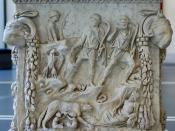How is the allegory of the cave in PlatoÃÂs Republic a good example of hubris; and how is hubris portrayed in LivyÃÂs, ThucydidesÃÂ, and EuripidesÃÂ respective works of literature?Hubris is an important term when it comes to classical literature especially to the Greeks, but also to the Romans. Hubris is excessive pride, often to the point where one is hurt in one way or another by it. Hubris is in the cave allegory from PlatoÃÂs Republic, but also in parts of EuripidesÃÂ The Bacchae, LivyÃÂs The Early History of Rome, and in ThucydidesÃÂ On Justice Power and Human Nature, and hubris is never viewed by either society as a positive, and the results of each story prove just that.
The allegory of the cave is explained as people chained to chairs in a cave that can only see shadows dancing in front them that are cast by people behind those in the chairs as sort of puppets, and the people believe these shadows to be reality.
ÃÂÃÂ the prisoners would in every way believe that the truth is nothing other than the shadows of these artifactsÃÂ (Plato 187). Plato goes on to theorize about what would happen if one of the prisoners were set free. He would see the real world, and learn that he was only seeing shadows of true life before. Then, what if that same prisoner were to go back into the cave? ÃÂÃÂ if he had to compete again with the perpetual prisoners in recognizing the shadows, wouldnÃÂt he invite ridicule? WouldnÃÂt it be said of him that heÃÂs returned from his upward journey with his eyesight ruined and that it isnÃÂt even worthwhile even to try to travel upward?ÃÂ (Plato 189). The contrast between the perpetual prisoners and the one who had seen the light is...


